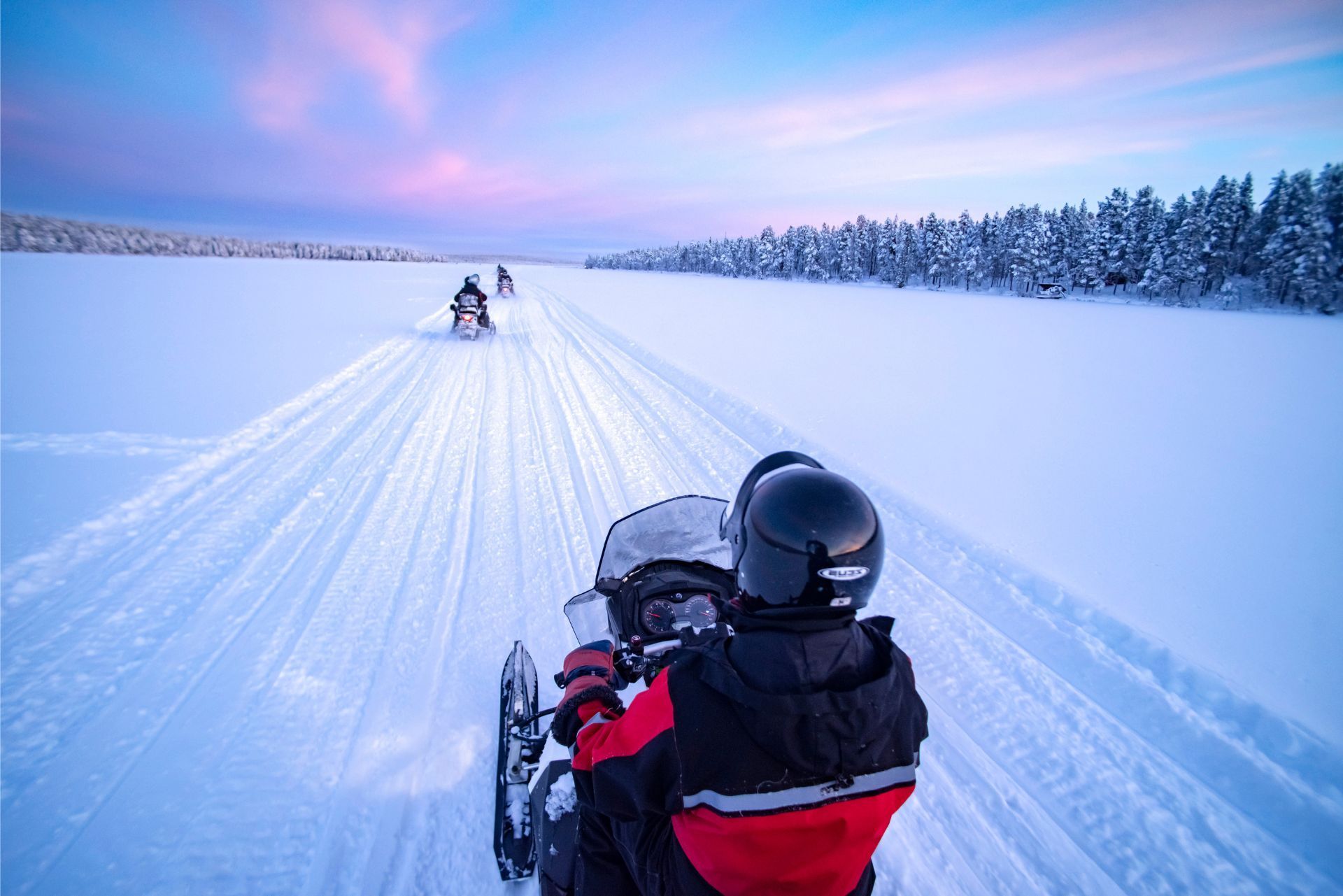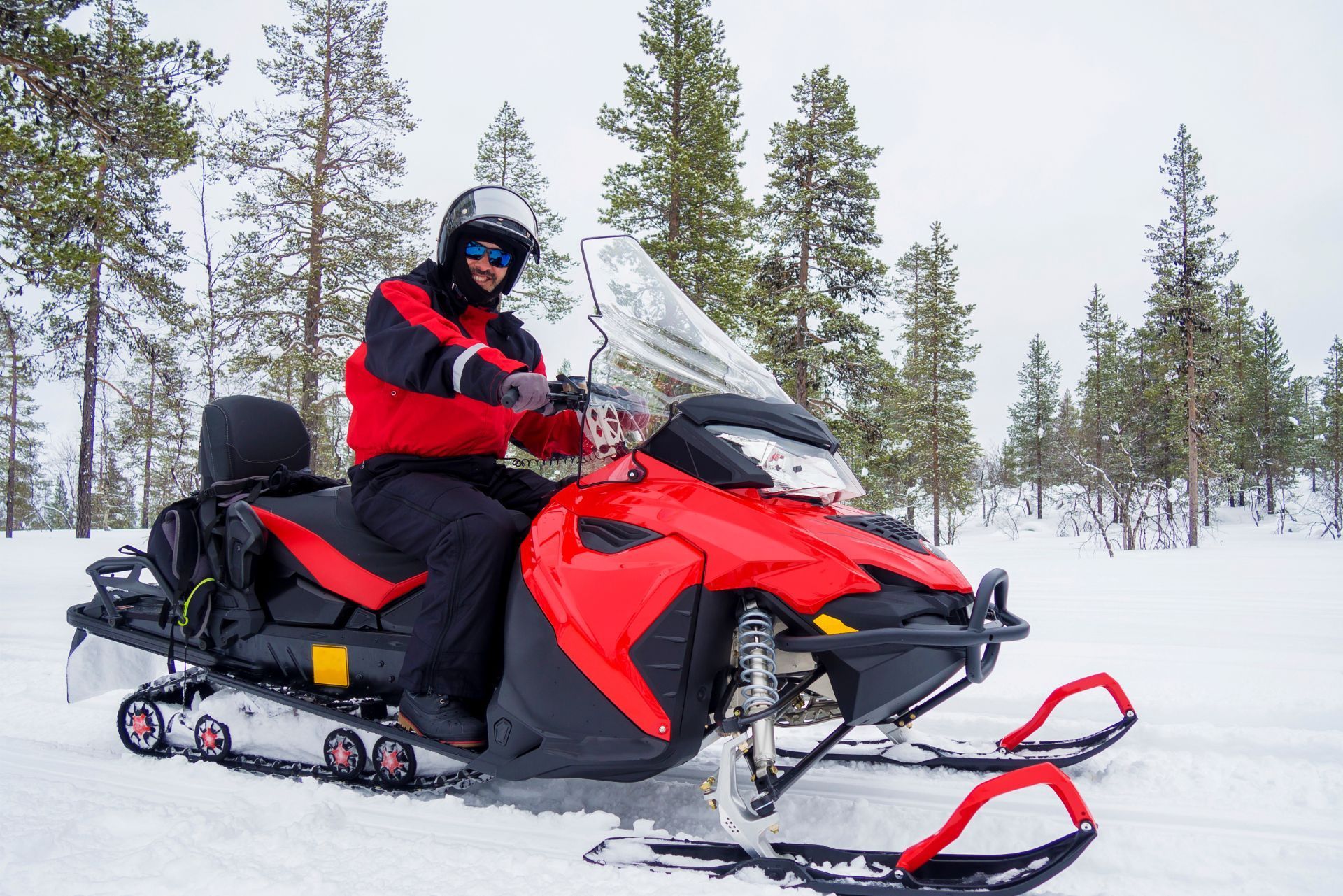Top 3 Recommended Policies

By: David Graves
Licensed Personal Insurance Specialist
425-320-4280
With 3,000 miles of marked trails, eight rugged national forests, and a winter season that often stretches from November to late April, Washington State is nothing short of paradise for snowmobile enthusiasts. The same deep powder that draws riders from Spokane to Snoqualmie also hides rocks, downed branches, and unexpected drop-offs. A single mishap can send repair bills soaring past four figures or lead to liability disputes that outlast the snowpack. Snowmobile insurance exists to soften those financial blows and keep adventures focused on exhilaration rather than expense. The guide below unpacks every angle of coverage, cost, and regulation so Washington riders can carve powder with confidence.
The Appeal of Snowmobiling in Washington State
Washington’s varied geography delivers a buffet of terrain most regions can only envy. Winter riders can trace groomed routes through the Alpine Lakes Wilderness one day, then thread tree-lined powder meadows on the eastern slopes of the Cascades the next. According to the Washington State Snowmobile Association, resident registrations hover around 35,000 sleds each year, with tourism adding thousands more visiting machines during peak season. Economic studies commissioned by the state Department of Commerce estimate snowmobiling pours nearly $200 million into local economies annually through lodging, fuel, permits, and outfitter services. This influx not only supports local businesses but also fosters a vibrant community of outdoor enthusiasts who share a passion for winter sports, often gathering at popular trailheads and events throughout the season.
That popularity creates crowded trailheads and, inevitably, more accidents. Washington State Parks tallied 127 reported snowmobile crashes and 12 fatalities over the most recent five-year period. While most incidents involve only the rider’s machine, approximately one in five leads to third-party property damage or bodily injury claims. These statistics underscore why both seasoned riders and newcomers should scrutinize insurance options before the first snowstorm hits. Additionally, safety courses and rider education programs are becoming increasingly vital, as they equip participants with essential skills and knowledge to navigate the diverse and sometimes challenging terrains safely. Many local organizations offer workshops that cover everything from basic snowmobile operation to advanced backcountry navigation, ensuring that riders are well-prepared to enjoy the exhilarating experience of snowmobiling while minimizing risks.

Is Snowmobile Insurance Required in Washington?
Washington law does not mandate insurance for snowmobiles in the same manner the state requires coverage for automobiles. Registration, which is handled through the Department of Licensing, focuses on a $50 seasonal sled permit and the statewide Sno-Park pass. However, land-management agencies, private trail clubs, and popular resort areas increasingly demand proof of liability coverage before granting trail access or event entry. In addition, lenders almost always stipulate comprehensive and collision coverage for financed sleds.
Even without a legal requirement, the potential financial exposure is significant. Washington’s average hospital stay following a snowmobile accident costs roughly $18,000, according to data from the University of Washington’s Harborview Injury Prevention Center. If a rider is found negligent, those medical costs—and any lost wages—may become out-of-pocket obligations. That risk explains why a growing share of Washington riders voluntarily carry policies that mirror the protections motorcyclists and boaters have long considered essential.
Moreover, the terrain in Washington can be both breathtaking and treacherous, with snow-covered mountains, dense forests, and winding trails that attract thrill-seekers and families alike. The beauty of the landscape can often lead to a false sense of security, as riders may underestimate the potential dangers associated with snowmobiling. In addition to accidents, riders need to be aware of the risks posed by avalanches, which can occur in certain areas, further emphasizing the importance of being prepared with adequate insurance coverage. Riders are encouraged to take safety courses and participate in local snowmobile clubs, which often provide resources and information about safe riding practices and the benefits of insurance.
Furthermore, as the popularity of snowmobiling continues to rise in Washington, so does the need for responsible riding practices. Many local organizations advocate for safe and sustainable snowmobiling, emphasizing the importance of respecting nature and fellow riders. By investing in insurance, riders not only protect themselves financially but also contribute to a culture of responsibility within the snowmobiling community. This commitment to safety and accountability can enhance the overall experience for everyone on the trails, ensuring that the thrill of snowmobiling can be enjoyed for generations to come.
Core Coverages Explained
Liability Coverage
Liability is the bedrock of any snowmobile policy. It pays when a rider is legally responsible for injuring another person or damaging someone else’s property. Washington insurers typically offer limits starting at $25,000 per person and $50,000 per accident for bodily injury, plus $10,000 for property damage. Many agents recommend at least $100,000/$300,000/$50,000 to match or exceed common auto limits and reduce the odds of paying excess damages personally. This coverage not only protects the rider financially but also provides peace of mind, allowing enthusiasts to enjoy their rides without the constant worry of potential legal repercussions. Moreover, understanding the nuances of liability coverage can help riders make informed decisions about their policy limits and additional riders that may be necessary based on their riding habits and the areas they frequent.
Collision and Comprehensive Coverage
Collision steps in when a sled hits a stationary object, another snowmobile, or rolls down a slope. Comprehensive, on the other hand, addresses non-collision losses such as theft, fire, vandalism, or storm damage while the machine sits on a trailer in summer storage. Deductibles range from $250 to $1,000; higher deductibles shave premiums but raise out-of-pocket costs after a claim. Because many Washington sleds retail for $12,000 to $18,000—and high-performance mountain models can top $20,000—owners often decide full physical damage protection is worth the modest annual fee. Additionally, riders should consider the frequency and type of their riding. For instance, those who often venture into rugged terrains or participate in competitive racing may find that comprehensive coverage is essential for safeguarding their investment against unforeseen events, such as an avalanche or extreme weather conditions that could lead to damage.
Medical Payments Coverage
Medical payments, or “med pay,” reimburses the rider and passengers for healthcare expenses regardless of fault. Typical limits are $2,000 to $10,000. This coverage shines during back-country excursions where evacuation via helicopter can exceed $5,000 before hospital bills even begin to mount. Med pay also bridges gaps when riders have high-deductible health plans or out-of-network complications. Furthermore, riders should be aware that medical payments coverage can also extend to passengers, making it a valuable addition for those who frequently ride with friends or family. In the event of an accident, this coverage can alleviate the financial burden on both the rider and their loved ones, allowing for a quicker recovery without the stress of mounting medical bills.
Uninsured/Underinsured Motorist (UM/UIM)
Because Washington does not compel snowmobile liability insurance, encountering an uninsured rider is entirely possible. UM/UIM coverage mirrors liability limits and activates when an at-fault party lacks adequate protection. It covers medical bills, lost wages, and pain-and-suffering damages for the insured rider and passengers, ensuring an accident with an uninsured sledder doesn’t derail financial stability. This coverage is particularly crucial in areas where snowmobiling is popular but regulations may be lax, as it provides an added layer of security for riders who may otherwise be left vulnerable. Additionally, riders should review their UM/UIM limits carefully, as they can vary significantly, and opting for higher limits can be a wise choice for those who frequently ride in crowded areas or participate in group outings where the risk of encountering uninsured riders is heightened.
Optional Add-Ons Worth Considering
Accessory and Gear Protection
Washington riders often invest hundreds—or thousands—in aftermarket performance parts, heated helmets, GPS units, and avalanche beacons. Standard comprehensive limits may cover only factory equipment. Accessory endorsements allow owners to schedule an additional $500 to $30,000 worth of add-ons so custom work and specialized safety gear are fully reimbursed after a covered loss.
Transport Trailer Coverage
Enclosed trailers and tilt-bed haulers can cost nearly as much as an older sled. Some home or auto policies extend limited protection, but many exclude trailers once they leave the residence. A snowmobile policy can add physical damage coverage for trailers, ensuring collisions en route to Snoqualmie Pass or a break-in at a hotel parking lot don’t demolish a weekend adventure budget.
Roadside and Towing Assistance
From blown drive belts to dead batteries in sub-zero temperatures, mechanical failures happen in the most inconvenient places. Roadside assistance endorsements typically cover on-trail labor, winching, fuel delivery, and tow-back services within a set mileage radius. Considering professional extraction from remote areas can top $400 per hour, the endorsement’s $20-to-$30 annual cost is an easy sell for riders who explore ungroomed terrain.
Personal Effects Coverage
Phones, action cameras, and avalanche backpacks travel along on virtually every ride. Personal effects coverage reimburses the replacement value of these belongings if they’re damaged or lost during a covered incident. Limits are usually offered in $500 increments up to $5,000, and claims generally carry no deductible, making it a convenient safety net for modern riders who never hit the trail without electronics.
Factors That Influence Your Premium
Insurance companies weigh a handful of characteristics when pricing a Washington snowmobile policy. Machine value, model year, and engine displacement form the starting point—high-horsepower models naturally cost more to insure. Where the sled is garaged matters too: zip codes with elevated theft rates, such as some urban fringes of Seattle and Tacoma, see slightly higher premiums. Riding history, safety course completion, and multi-policy bundling provide the biggest discounts and can shave 10 % to 25 % off annual costs.
Usage patterns also sway rates. A sled used solely on private rural property may qualify for a reduced “farm use” premium. Conversely, frequent back-country expeditions or competitive racing add surcharges because claims data show higher accident frequencies in those environments. Riders hoping to trim costs should keep detailed logs of mileage and trail systems to help agents match the policy to actual risk.
How Much Does Washington Snowmobile Insurance Cost?
Most riders in Washington pay between $120 and $300 per year for a basic liability-plus-comprehensive package on a single recreational sled. Mid-range mountain machines with accessory endorsements and $500 deductibles commonly fall in the $240-to-$450 bracket. Premiums spike for performance turbo models, with fully loaded policies occasionally surpassing $600 annually—still modest when compared to car insurance averages in King County, which hover near $1,300.
To illustrate, consider two hypothetical riders. Rider A insures a 2018 600 cc trail sled valued at $7,500, opts for $50,000/$100,000 liability and $1,000 deductibles, and stores the sled in Wenatchee. The quoted premium is roughly $185. Rider B covers a 2023 850 cc mountain sled valued at $17,000, selects $100,000/$300,000 limits, a $500 deductible, accessory coverage of $3,000, and lives in suburban Tacoma. The resulting premium: about $395. These examples highlight how sled value, location, and deductible choices dictate cost more than any single factor.
Tips for Saving on Your Policy Without Sacrificing Protection
Premium-cutting strategies rarely require sacrificing coverage depth. Instead, insurers reward riders who demonstrate risk mitigation and loyalty. The checklist below gathers the most effective tactics:
- Complete a state-approved snowmobile safety course for a 10 % to 15 % discount.
- Bundle snowmobile coverage with home, auto, or RV policies to unlock multi-line savings up to 20 %.
- Install an ignition kill switch and GPS tracker; many carriers lower comprehensive rates when theft-deterrent devices are present.
- Choose the highest deductible you can comfortably afford to pay out-of-pocket, then stash that amount in a dedicated savings account.
- Ask about storage or lay-up endorsements if the sled sits idle for more than six consecutive months—you’ll pay only for comprehensive during the off-season.

Claims Process – What to Expect After an Incident
Filing a snowmobile claim in Washington mirrors the auto process but with a few winter-specific twists. First, contact authorities or ski patrol if injuries occur, both for medical help and an official report. Next, notify the insurer within 24 hours, supplying photos of the scene, GPS coordinates, and contact information for witnesses. Carriers often dispatch field adjusters skilled in powersports equipment to assess damage on-site or at a partner repair shop.
After documentation, the adjuster estimates repair costs or totals out the sled based on actual cash value minus the deductible. Reimbursement for accessories hinges on proper receipts or photos proving prior installation. For liability claims, the insurer’s legal team negotiates with injured third parties, keeping the policyholder informed of settlement progress. Most property-damage claims close within two weeks; bodily injury cases can require several months, especially if long-term rehabilitation factors into compensation calculations.
Finding the Right Insurer: Key Questions to Ask
Washington riders enjoy a competitive market, with regional mutual companies and national giants alike vying for snowmobile customers. Beyond premium quotes, the following questions separate solid providers from the merely adequate:
What percentage of claims are settled in 30 days or less? Do adjusters have specialized snowmobile training? Are OEM parts guaranteed for repairs, or will aftermarket substitutes be used? How are accessories valued—actual cash value or replacement cost? Does the carrier offer disappearing deductibles or loyalty credits after claim-free seasons? Satisfactory answers to these points indicate an insurer committed to rider-centric service rather than one-size-fits-all underwriting.
Frequently Asked Questions
Does my homeowners or auto policy automatically cover my snowmobile?
Standard homeowners and auto policies exclude motorized recreational vehicles once they leave your property. Some limited theft coverage might apply while the sled sits in the garage, but liability and collision are almost always omitted. A dedicated snowmobile policy is the only reliable way to guarantee full protection on and off the trail.
Are passengers covered under my liability policy?
Yes. Liability protection extends to bodily injury sustained by passengers, bystanders, or other riders when the policyholder is at fault. However, passengers who own separate snowmobile policies should file under their own medical payments coverage first, then turn to the at-fault rider’s liability if expenses exceed their limits.
Will a single policy cover multiple sleds?
Most insurers allow up to four snowmobiles on one policy, each listed with its own VIN, coverage selections, and accessory limits. Multi-sled households receive premium breaks of 10 % or more, making this configuration more economical than carrying separate policies for every machine.
Final Thoughts
Washington’s expansive winter playground rewards those who prepare as carefully as they ride. While the state stops short of mandating snowmobile insurance, the financial realities of modern medical care, equipment costs, and potential liability leave little doubt that coverage is a wise investment. By understanding core protections, optional add-ons, and the factors that influence price, riders can tailor a policy as precisely as they tune suspension for fresh Cascade powder. The result is simple: more epic days on the throttle, fewer sleepless nights worrying about what might go wrong after the next snow squall.

